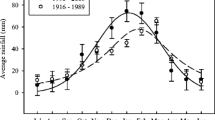Summary
The present study deals with fertility changes in agro-ecosystems where vegetation is removed by slash and burn procedures, the land is planted to crops (cultivated) for one year, and then left to revegetate naturally for upto 50 years (forested fallow, here after referred to as ‘fallow’) before the entire cycle (locally called ‘Jhum’) is repeated. A comparison has been made between three jhum cycles of 30, 10 and 5 years. Depletion in soil carbon continued throughout the cropping period of one year and extended upto a 5 year fallow. This could be one of the reasons against a short jhum cycle, alongwith a similar pattern in depletion of nitrogen. Available phosphorus build up in the fallows also starded only beyond a 5 year fallow period with rapid increase in 10, 15 and 50 year fallows. Cationic concentration in the soil also rapidly declined in the early phases of regrowth of vegetation. This decline was most pronounced for potassium due to the fact thatDendrocalamus hamiltonii is a heavy accumulator of this nutrient. Since this bamboo species dominates the fallow upto about 20 years, potassium build up in the soil was observable only at this stage. It is suggested that this species plays an important role in conservation of this nutrient. In a 50 year fallow, low levels of calcium and magnesium were maintained with rapid depletion of both with depth which is in contrast to that of potassium and phosphorus. In general, short jhum cycles of 5 year permit only low levels of soil fertility with very poor recovery during the fallow period. The significance of these results are discussed.
Similar content being viewed by others
References
Ahlgren, I. F. and Ahlgren, C. E. 1965 Effect of prescribed burning on soil microorganisms in a Minnesota jack pine forest. Ecology46, 304–310.
Allen, S. E. (Ed.) 1974 Chemical Analysis of Ecological Materials. Blackwell Scientific Publ. Oxford.
Birch, H. F. and Friend, M. T. 1956 The organic matter and nitrogen status of east African Soils. J. Soil Sci.7, 156–167.
Coulter, J. K. 1950 Organic matter in Malayan Soils: A preliminary study of the organic matter content in soil under virgin jungle, forest plantations and abandoned cultivated land. Malay. For.13, 189–202.
Ewel, J. J. 1976 Litter fall and leaf decomposition in a tropical forest succession in eastern Guatemala. J. Ecol.64, 203–308.
Griffith, G. 1949 Fertility problems in Ugenda. Commonw. Bur. Soil Sci. Tech. Commun. No.46, pp 160–164.
Jenny, H. and Ray Chaudhuri, S. P. 1960 Effect of Climate and Cultivation on Nitrogen and Organic Matter Resources in Indian Soils. Ind. Counc. Agric. Res., New Delhi.
Jha, M. N., Pande, P. and Pathak, T. C. 1979 Studies on the changes in the physio-chemical properties of Tripura soils as a result of Jhuming. Indian For.105, 436–443.
Joachim, A. W. R. and Kandiah, S. 1948 The Effect of shifting (Chena) cultivation and subsequent regeneration of vegetation on soil composition and structure. Trop. Agric.104, 3–11.
Juo, A. S. R. and Lal, R. 1977 The effect of fallow and continuous cultivation on the chemical and physical properties of an alfisol in Wester Nigeria. Plant and Soil47, 567–584.
Laudelot, H. and Meyer, J. 1954 Les Cycles d'élements minérales at de matiére organique en forêt équatoriale congolaise. Trans. 5th Int. Congr. Soil Sci.2, 267–272.
Melillo, J. M. 1977 Mineralization of Nitrogen in Northern Forest Ecosystems. Ph.D. Thesis, Yale Univ. New Haven, CT. 136 p.
Moore, A. W. and Jaiyebo, E. O. 1963 The influence of cover on nitrate and nitrifiable nitrogen content of the soil in a tropical rain forest environment. Emp. J. Exp. Agric.31, 189–198. (163).
Nye, P. H. and Bertheux, M. H. 1957 The distribution of phosphorus in forest and savannah soils of the Gold Coast and its agricultural significance. J. Agric. Sci. Camb.49, 149–159.
Nye, P. H. and Greenland, D. J. 1960 The Soil under Shifting Cultivation. Tech. Comm. No.51, Comm. Bur. Soils, Harpenden.
Nye, P. H. and Greenland, D. J. 1964 Changes in the soil after clearing tropical forest. Plant and Soil21, 101–112.
Ramakrishnan, P. S., Toky, O. P., Misra, B. K. and Saxena, K. G. 1980 Slash and burn agriculture in north-eastern India.In Fire Regimes and Ecosystem Properties. Eds. H. Mooney, J. M. Bonnicksen, N. L. Christenson, J. R. Lotan and W. A. Reiners, U.S.D.A. For. Ser. Gen. Tech. Report, Washington, D.C.
Reed, W. E. 1951 Reconnaissance Soil Survey of Liberia. U.S.D.A. Agric. Inf. Bull.66, Washington.
Rice, E. L. 1974 Allelopathy. Acad. Press, New York, NY, 353 pp.
Russell, E. W. 1968 Some agricultural problems of semi-arid areas.In Soil Resources of Tropical Africa. Ed. R. P. Moss. Camb. Univ. Press.
Smith, W. H., Bormann, F. H. and Likens, G. E. 1968 Response of Chemoautrophic nitrifiers to forest cutting. Soil. Sci.106, 471–473.
Toky, O. P. and Ramakrishnan, P. S. 1980 Cropping and yields in agricultural systems of the north-eastern hill region of India. Agro-Ecosystem8, (in press).
Valentine, P. S. 1976 A preliminary investigation into the effect of clear cutting and burning on selected soil properties in Pemberton area of western Australia. Geowest8, 43.
Went, F. W. and Stark, N. 1968 Mycorrhiza. Bio Science18, 1035–1039.
Zinke, P. J., Sabhastri, S. and Kunstadter, P. 1978 Soil fertility aspects of the ‘Lua’ forest fallow system of shifting cultivation.In Farmers in the Forest. Eds. P. Kunstadter, E. C. Chapman and S. Sabhastri. East-West Centre, Honululu, Hawaii.
Author information
Authors and Affiliations
Rights and permissions
About this article
Cite this article
Ramakrishnan, P.S., Toky, O.P. Soil nutrient status of hill agro-ecosystems and recovery pattern after slash and burn agriculture (Jhum) in north-eastern India. Plant Soil 60, 41–64 (1981). https://doi.org/10.1007/BF02377111
Received:
Revised:
Issue Date:
DOI: https://doi.org/10.1007/BF02377111




